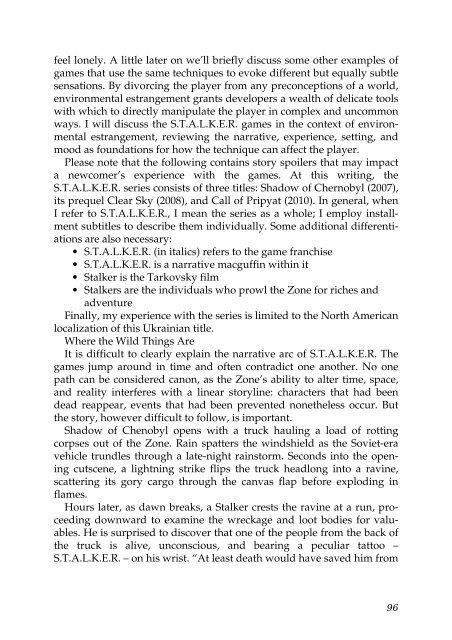Well Played 2.0: Video Games, Value and Meaning - OpenLibra
Well Played 2.0: Video Games, Value and Meaning - OpenLibra
Well Played 2.0: Video Games, Value and Meaning - OpenLibra
You also want an ePaper? Increase the reach of your titles
YUMPU automatically turns print PDFs into web optimized ePapers that Google loves.
feel lonely. A little later on we’ll briefly discuss some other examples of<br />
games that use the same techniques to evoke different but equally subtle<br />
sensations. By divorcing the player from any preconceptions of a world,<br />
environmental estrangement grants developers a wealth of delicate tools<br />
with which to directly manipulate the player in complex <strong>and</strong> uncommon<br />
ways. I will discuss the S.T.A.L.K.E.R. games in the context of environmental<br />
estrangement, reviewing the narrative, experience, setting, <strong>and</strong><br />
mood as foundations for how the technique can affect the player.<br />
Please note that the following contains story spoilers that may impact<br />
a newcomer’s experience with the games. At this writing, the<br />
S.T.A.L.K.E.R. series consists of three titles: Shadow of Chernobyl (2007),<br />
its prequel Clear Sky (2008), <strong>and</strong> Call of Pripyat (2010). In general, when<br />
I refer to S.T.A.L.K.E.R., I mean the series as a whole; I employ installment<br />
subtitles to describe them individually. Some additional differentiations<br />
are also necessary:<br />
• S.T.A.L.K.E.R. (in italics) refers to the game franchise<br />
• S.T.A.L.K.E.R. is a narrative macguffin within it<br />
• Stalker is the Tarkovsky film<br />
• Stalkers are the individuals who prowl the Zone for riches <strong>and</strong><br />
adventure<br />
Finally, my experience with the series is limited to the North American<br />
localization of this Ukrainian title.<br />
Where the Wild Things Are<br />
It is difficult to clearly explain the narrative arc of S.T.A.L.K.E.R. The<br />
games jump around in time <strong>and</strong> often contradict one another. No one<br />
path can be considered canon, as the Zone’s ability to alter time, space,<br />
<strong>and</strong> reality interferes with a linear storyline: characters that had been<br />
dead reappear, events that had been prevented nonetheless occur. But<br />
the story, however difficult to follow, is important.<br />
Shadow of Chenobyl opens with a truck hauling a load of rotting<br />
corpses out of the Zone. Rain spatters the windshield as the Soviet-era<br />
vehicle trundles through a late-night rainstorm. Seconds into the opening<br />
cutscene, a lightning strike flips the truck headlong into a ravine,<br />
scattering its gory cargo through the canvas flap before exploding in<br />
flames.<br />
Hours later, as dawn breaks, a Stalker crests the ravine at a run, proceeding<br />
downward to examine the wreckage <strong>and</strong> loot bodies for valuables.<br />
He is surprised to discover that one of the people from the back of<br />
the truck is alive, unconscious, <strong>and</strong> bearing a peculiar tattoo –<br />
S.T.A.L.K.E.R. – on his wrist. “At least death would have saved him from<br />
96

















